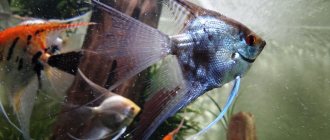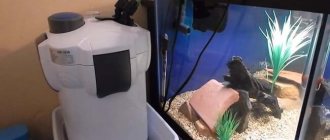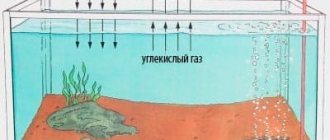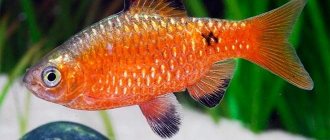Fish are unpretentious and entertaining pets that do not cause allergic reactions. Therefore, they do not cause much trouble to the owners. Of course, for such wonderful creatures you want to create the most comfortable atmosphere possible: buy good soil, a high-quality aquarium filter, and the right food. They live in a confined space; in order to feel great in it, they need the right filler. For example, such as Java moss, which will decorate a glass house and create suitable conditions for reproduction. It reacts normally to an alkaline environment and serves as a shelter for fry.
What is Java moss?
Java moss is an ornamental plant suitable for any aquarium. The species belongs to the Hypnidae family. It does not have a root system - this is both a plus and a minus. It can grow anywhere in a home pond, on the walls, roof, both vertically and horizontally. This can be dangerous because... it can grow in the filter, on decorative decorations.
This epiphyte is native to Southeast Asia and the island of Java. Perhaps this explains his unpretentiousness. The thin (up to 2 mm) but long (up to 45 cm) stem, for which this aquarium resident is known, is covered with thin leaves that change color, depending on lighting and oxygen saturation. It is also capable of absorbing harmful substances that accumulate in the aquarium.
Appearance and conditions of detention
Depending on the degree of grooming, Java moss looks like a lot of intertwined thin thread-like stems with small leaves. The leaves, grouped in pairs, are oval in shape and up to 2 mm long.
As expected, the appearance of the plant is influenced by the conditions of its maintenance. For example, a bush grown under water is smaller than one growing in the humid climate of a greenhouse.
Like other mosses, Taxiphyllum Barbieri (Java moss) has no roots. The plant is attached to the substrate using special organs - rhizoids. They do not take part in the feeding process. Absorption of “food” occurs through the stems and leaves.
Java moss is undemanding in terms of maintenance conditions. However, without creating better conditions for it, it is unlikely that it will be possible to achieve the beauty of the bush.
Ideal conditions of detention are:
- pH 5 - 8. Slightly acidic water is preferable to neutral.
- Water flow in the aquarium.
- Temperature from 21 to 24 oC. It can grow at temperatures up to 30 degrees, however, values higher than optimal will seriously inhibit plant growth.
- Water hardness does not play a special role for the plant. Moss can grow even in slightly brackish water.
Java moss grows in both low and bright light. However, the intensity of light affects the appearance. In low light it is darker and grows slowly.
Fertilizers and CO2 can be added to speed up the growth rate. But, to be honest, the plant grows well without additional feeding. He gets enough of what is in the water from the life activity of the inhabitants of the aquarium.
Java moss reproduces in an aquarium mainly from pieces of the mother plant. When exposed to moist air, it produces spores.
Conditions of detention
In professional literature and on amateur websites on the Internet, a common thread is the idea that the aquarium plant Java moss is almost the most profitable aquatic organism. This is because it requires almost no attention. Or rather, the Javanese is able to easily adapt to changing circumstances. Unlike algae, it does not need soil, it can be grown on all surfaces, from driftwood to plastic tubes, stones, it will even grow on the wall of an aquarium. It is important for him that there is a suitable temperature nearby (up to 30 ° C) and daylight hours do not last less than 8 hours. It’s good if there is no bright light falling on him, but if there is none, he will also survive.
Another important point that makes breeding this miracle successful is the purity of the water. It needs to be filtered, all fish waste products and food residues are removed, otherwise the pores become clogged and the fish dies. The acidity of the environment should not exceed 8 ph, and water hardness should not exceed 15 °. In order for it to grow healthy and please the eye, you need a “dwelling” with a volume of at least 100 liters. You should not move it from place to place, because... it will make him weak. Particular attention should be paid to its appearance, if the owner notices a coating on the leaves - this is the main signal indicating that the water needs to be changed, washing the leaves with special care.
There are also two principles that should be taken into account if someone is going to grow this living decoration:
- it should not be allowed to grow too much;
- it is vulnerable to attacks from some aquatic inhabitants, but gets along well with neons, angelfish and shrimp.
If desired, you can build a small current; all bryophytes love this. But blue-green algae and black beard are direct enemies. If such a neighborhood is allowed, then the Javanese faces imminent death.
Content
Vesicularia is a very hardy plant. Like many types of moss, it can grow in any light. But with a more powerful stream of light, it begins to grow vigorously and branch more. The thickets become dense and bright green.
The temperature range is quite wide: from 22 to 30ºС. Temperature fluctuations from the specified limit lead to a slowdown in growth. Development stops, but visual changes can be noticed only after a few weeks.
Java moss is completely unpretentious to the active reaction of water and its hardness. It can even grow in water containing salt (2-3 ppm).
Java moss places high demands not on hydrochemical parameters, but on water quality. Dirty water leads to the gradual decline of the plant. Organic deposits cover the leaves and thereby not only spoil the decorative appearance, but also disrupt the nutritional system.
Javanese, as aquarists call the plant, loves moderate currents. But if parts of the stems are nailed to the filter, then moss can easily grow on it, which requires special monitoring of the plant.
The presence of soil is not important for Java moss. It gets all its nutrients from water. Vesicularia dubayana can simply grow on the bottom. To do this, it is not necessary to roll it with a stone. Moss is heavy and sinks under its own weight. Fasteners are needed to indicate a specific location.
See how to plant Java moss:
A mandatory procedure when keeping Java moss is cutting. But this process must be accompanied by a siphon of soil and water. Even the smallest, unharvested shoots can germinate anywhere. Frequent cuttings increase the density and branching of the thickets. Java moss be trimmed last, so that during the work the current does not have time to spread its pieces throughout the aquarium.
Vesicularia growing in the foreground is trimmed exclusively with scissors. Bushes attached to snags and stones can be plucked off.
The most dangerous enemy of Java moss is algae. The fight against blackbeard or blue-green algae is carried out using drugs and mechanically. The ability of Java moss to exist without being completely immersed in water allows it to be periodically removed from the aquarium and thus fight algal growth. When using chemicals, keep in mind that Java moss is very sensitive to treatment with bleach solution. You can rid the plant of fouling by placing it in a container with tap water and placing it in a dark place. After a week, with daily water changes, the algae will die.
Where and how does moss grow?
Vesicularia dubayana is a life-loving organism that survives in all conditions close to tropical. If you can create the right environment around it, it grows faster than algae and in a few weeks turns from a small twig into a large dense bush. Of course, if he has enough light and does not suffer from low temperatures (less than 21°). It is also found naturally in India and Malaysia. If you take care of it responsibly, you will get a fast-growing miracle that can not only decorate a home for fish, but also serve as a good shelter for future offspring.
Designer finds
It is difficult to imagine another species known to the aquarium hobby that is more suitable for decoration than mosses. They make a whole green wall. You will need: a mesh made of stainless steel or dense plastic, with suction cups on the sides, a sprinkler, a knife, scissors, fishing line or thread. First of all, the moss is laid out on a grid suitable in size for the aquarium. This is a rather labor-intensive and lengthy process. It is secured so that the sprouts do not touch each other and do not touch the bottom.
Representatives of the hypnotic species sprout almost everywhere. You can plant them on anything - any surface will do: old children's toys, bright hairpins, shells. How to attach such parts depends on the flight of fancy, wire, rope, glass, you just have to remember that all this will be overgrown with moss.
Java moss: how to plant
To get chic decor and a peaceful design in a single room, everything is important; Java moss must have proper maintenance, care, lighting, this is a guarantee of an excellent result. But these are nuances; if you make mistakes in planting, you won’t get the desired effect.
It is contraindicated to grow a luxurious bush in dirty water, so the first thing that needs to be done is filtration and treatment of the water with special means. Small decorative shoots are laid out on the selected surface and tied with thread at a short distance from each other. After a few days, there is no free space left on the Vesicularia dubayana fixed in this way, because it is growing.
To the conclusions. This beautiful representative of mosses will decorate any aquarium. Moss that is grown according to the correct recommendations will make a wonderful living area or decoration. He interacts wonderfully with aquatic inhabitants. Attaching it to interesting details will be wonderful entertainment and a reason to periodically change the interior.
Video on Java moss
How to attach Java moss to driftwood in an aquarium
The Javanese is attached to driftwood in the same way as to stones - with a thread. Some YouTube videos recommend using glue. However, I do not recommend doing this myself. No matter how much is said about the harmlessness of glue for fish and other inhabitants of the aquarium, it is still chemistry. Thus, the best material for tying to a snag (stone) is fishing line or ordinary cotton thread.
The mounting process is simple. A section of the plant is applied to the surface of the snag and tied tightly with thread. The work should be done carefully. A thread (fishing line) that is pulled tightly can cut branches.
At first, the fixed moss grass does not look aesthetically pleasing. However, everything will soon return to normal. It grows quite quickly, covering the substrate. You can see how to attach Java moss to driftwood from the video.
Nothing complicated.
Creating a carpet on the wall of an aquarium or on the bottom is just as easy. Only in this case will you have to use a nylon mesh with a medium-sized mesh.
Using ordinary threads, you don’t have to worry that when the thread rots, the moss will no longer hold on. By that time, the rhizoids will already reliably hold the plant to the base.
Now we should talk about the “cons” of keeping Taxiphyllum Barbieri (Java moss).





